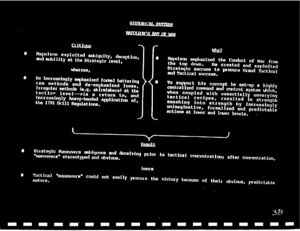Patterns of Conflict
| The works of |
| Works of John Boyd |
|---|
OODA WIKI Edition
Quantico Transcription
He did exploit ambiguity, deception and mobility, at the strategic level. Look what happened down at the tactical level. Actually a return to the 1791 Drill Manual. He ran a very heavy-handed application, that prescribed the use of line and column. Generally line for attack and column for movement [unintelligible].
Okay. And he emphasized the conduct of war from the top down. He wanted to get strategic success, he wanted to gain grand tactical success, and then tactical success. Strictly a top-down mentality. To support his concept, he set up this highly centralized command and control. Whereas he had a scheme in his mind, his marshals didn’t know. Since they didn’t know, they had to do what he wanted to do. And they worried about their own troops wouldn’t do it. It gets more and more rigid as you go down lower and lower.
So the result is strategic maneuvers, ambiguous and deceiving prior to tactical concentration. After concentration, stereotyped and obvious. And he could not procure the victory because of their obvious, predictable nature. Waterloo’s a good example. Christ, he made some mean strategic moves. Then it was “hi diddle diddle, right up the middle.” He got taken out.
Not only that, Wellington, as I told you before, said Napoleon came on the same old way and we beat him in the same old way. Napoleon figured out how to take on those line and columns down in Spain. Napoleon used the same technique. He used the same technique against them.
